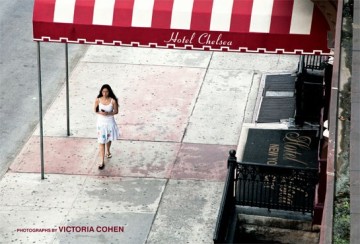
Originally published in the Marina Times San Francisco in December 2013
A Larry Rivers painting, drag queens using a phone booth as a changing room, and an animated group of partygoers emerging from the lobby elevator: These are some of the memories that Victoria Cohen shares in her new book of photographs of the Hotel Chelsea.
She can’t help but look back 25 years earlier and remember the Chelsea as she stood in the lobby waiting for a friend. The Hotel Chelsea’s particular brand of quirky charm is the subject of her first collection of photographs. But, instead of the bustling chaos of the hotel’s past, the viewer is confronted with a series of rooms void of people. Some contain ornate fireplaces, decor rich in textured color and views out of expansive windows. Others appear minimal. A room with a tidy bed, its blankets and pillows smoothly ordered, is punctuated by the absence created by an empty chair.
Located at 222 West 23rd Street in New York City, the Hotel Chelsea was constructed in 1883 and went on to become one of the city’s historical landmarks in 1966 due in no small part to the famous inhabitants who visited the hotel through the years. Artists from Henri Cartier-Bresson to Robert Crumb frequented the Chelsea along with writers and musicians including Bob Dylan, Gregory Corso, Herbert Huncke, Dylan Thomas, Patti Smith, Brigid Berlin and Charles Bukowski.
In 2011, the hotel was sold and its new owners decided to renovate the space. The very idea of refreshing the hotel’s look seemed to contradict the creative bohemian history and landmark status of the Chelsea. That’s when Victoria Cohen gained access to the uninhabited space to document the dwellings where so many songs, stories and artworks were conceived before the interiors were forever altered.
The resulting photography collection communicates a haunted beauty that, like a time capsule, forces the viewer to imagine these spaces occupied by its storied tenants who lived and sometimes died within the walls of the Chelsea. There’s a certain tension and anticipation associated with the images since Cohen knows that the clock is ticking. Passageways, doors, light fixtures, corners, dated yet charming kitchenettes and dining sets—aspects of the hotel that might only receive a casual glance from an occupant— are documented with devotion through the camera’s lens. Throughout the book, absence consistently suggests presence. Cohen’s lush photographic style and keen sense of composition captures and preserves the space where so many dreams were born.